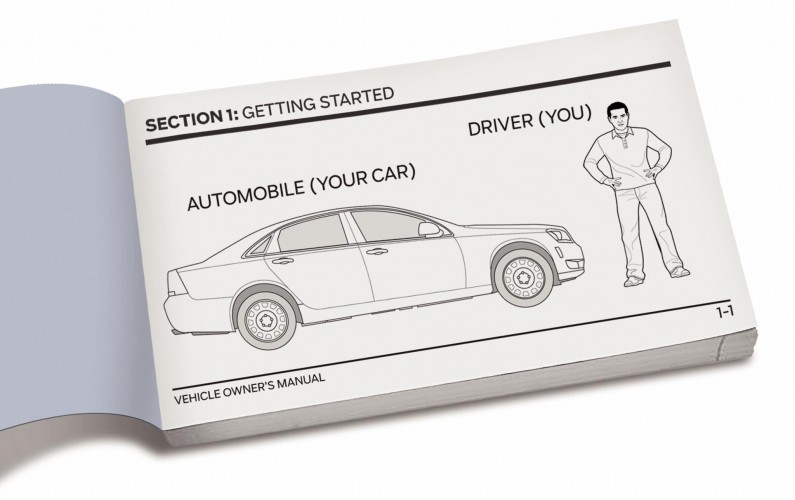
Brought to you by HSBC
![]()
The appreciation of motor vehicles is very much part of the culture in this transport-dependent modern world. Everyone wants to own one, but at the end of the day, very few are aware of the care and maintenance that a vehicle requires. After purchasing a motor vehicle, it is prone to wear and tear and mishaps that can lead to the deterioration of the vehicle sooner than it should. In order to avoid this, one must learn to understand their motor vehicle better.
How To Understand The Owner’s Manual?
Admit it, the last thing you do when you buy a brand new car is read the owner’s manual. We keep it somewhere safe and then never look at it again. Then, when something goes wrong, we usually have no idea what to do. First, it is important to understand that though not all owner manual are exactly the same, they’ll generally have similar layouts.

It is important to understand that all owners manuals are the same. Image credit: http://www.chicagotribune.com/classified/automotive/sc-cons-0515-autocover-owners-manuals-20140515-story.html
The first few pages of the owner’s manual will introduce you to your vehicle. These pages will also explain the symbols on the instrument panel as well as the controls in the car. The four most important sections to pay attention to are the instruments and controls, driving and operating, vehicle care, and service and maintenance. These parts will explain all the simple, yet important information about basic day-to-day car maintenance. It will also explain information about what oil to use, how to change your tires and how to check the fuse.
The instruments and control section will introduce you to all your controls, where to find them and how to use them. It will also introduce you to your dashboard warning lights that will inform you if your car needs to be serviced, if you are running low on fuel or coolant, or need to check your engine. The warning lights turn on to warn the owner prior to any damage, therefore it is important to keep an eye out and understand what they mean.

The dashboard warning lights will tell you everything you need to know about your vehicle. Image credit: https://www.mynrma.com.au/cars-and-driving/car-servicing/resources/what-do-my-dashboard-warning-lights-mean
The driving and operating section of the manual is a simple and small section that is usually overlooked. It contains information on how to drive your vehicle on all surfaces such as sand or snow. This section will also instruct you on how to handle your vehicle if you lose control.
One of the most important sections of the manual, however, is the one on vehicle care. This section focuses on engine oil, air filter, engine coolant, washer fluid, brake fluid, electrical systems, wheels and tires and the battery. The engine oil section of the manual will introduce you to what type of engine oil your car requires and how often you need to change it. The air filter section will instruct you on how to check and change your air filter. It will also tell you how often it must be changed. Like the section on engine oil, the sections on engine coolant, washer fluid and brake fluid will instruct you on what type to use, when to change it and how the change should be done. The section on electrical systems will direct you to the fuse box and instruct you on what each fuse stands for. The wheels and tires section will tell you everything you need to know about the way wheels react to seasons, their labeling, tire size, PSI information, how to change your tire and more. The section on the battery of the manual will instruct you how to jump-start your battery and what battery your vehicle contains.

Reading your owner’s manual early will be useful in times of need. Image credit: https://www.yourmechanic.com/article/the-10-most-important-things-in-your-car-owner-s-manual
The final section of your user’s manual is on service and maintenance. This section will inform you on when you should change your tires, battery, your belts, brakes and vehicle fluids. It will also provide you information wheel alignment, windshield care, and wiper blade replacement.
Clean It Like You Mean It
The owners manual will educate you on how to understand your vehicle, but it’s not only what’s on the inside that counts. A car must be as beautiful on the inside at it is out. Therefore, it is important to understand how to clean and take care of the exterior of your vehicle.
Weekly washes and careful hand drying is the best way to care for your vehicle’s surfaces. The most important thing to keep in mind when washing your vehicle, whether you wash it yourself or hand it over to car care professional, is to always protect the paint. If not done properly, swirls and scratches may appear on your paint that will require compounding and polishing to remove.
Contaminants from the environment can do serious damage to your vehicle if kept too long, thus weekly washes are necessary. Bugs or bird droppings, for example, are bio-hazardous and contain complex proteins that can bond to the surface and organic acids that will penetrate and break down the surface of the vehicle and eat into the paint if not washed off properly. This can lead to discoloration and corrosion of your vehicle.

Weekly cleaning with proper cleaning tools will keep your is the best way to take care of your vehicle’s surface. Image credit: http://blog.landroverhinsdale.net/car-washing-tips-101/
Another contaminant that can affect your vehicle is brake dust as it contains metal shavings from rotors and adhesives used in the production of brake pads. Brake dust is highly corrosive and sticky. Thus regular washes will prevent permanent damage.
It is important to keep in mind that you should never wash your car in direct sunlight. It is also important to choose equipment that is gentle on the paint but strong enough to remove contaminations. Therefore, a sponge or a mitt would be an ideal tool as it contains natural fibers that are not harmful to the paint. The wheels must be washed first to avoid sand or mud spreading onto the vehicle. The wheels can be washed with a stronger bristles.
It is also important never skip drying your vehicle after washing it. Drying prevents water spots and will eliminate outlines of water drops. The outlines are caused by minerals in the water and as the water evaporates, the minerals remain on the surface.
—
Take care of your vehicle with Sri Lanka’s top Auto Care Dealers by logging on to http://www.hsbc.lk/1/2/personal/credit-card/shopping-and-retail?WT.mc_ID=cc_roar_AutoServices for special offers.
Featured image courtesy: http://motortorque.org







